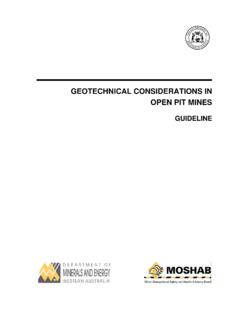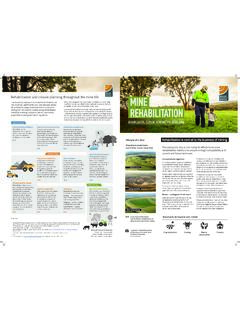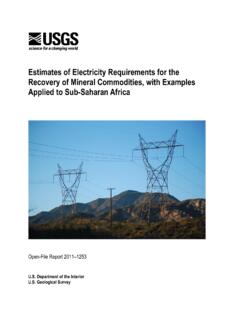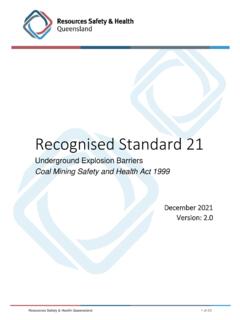Transcription of Abandoned mines and the water environment
1 Abandoned mines and thewater environmentScience project SC030136-41 Product code: SCHO0508 BNZS-E-Pii Science Report Abandoned mines and the water environment The environment Agency is the leading public body protecting and improving the environment in England and Wales. It s our job to make sure that air, land and water are looked after by everyone in today s society, so that tomorrow s generations inherit a cleaner, healthier world. Our work includes tackling flooding and pollution incidents, reducing industry s impacts on the environment , cleaning up rivers, coastal waters and contaminated land, and improving wildlife habitats. This report is the result of research commissioned and funded by the environment Agency s Science Programme. Published by: environment Agency, Rio House, Waterside Drive, Aztec West, Almondsbury, Bristol, BS32 4UD Tel: 01454 624400 Fax: 01454 624409 ISBN: 978-1-84432-894-9 environment Agency August 2008 All rights reserved.
2 This document may be reproduced with prior permission of the environment Agency. The views and statements expressed in this report are those of the author alone. The views or statements expressed in this publication do not necessarily represent the views of the environment Agency and the environment Agency cannot accept any responsibility for such views or statements. This report is printed on Cyclus Print, a 100% recycled stock, which is 100% post consumer waste and is totally chlorine free. water used is treated and in most cases returned to source in better condition than removed. Further copies of this report are available from: The environment Agency s National Customer Contact Centre by emailing: or by telephoning 08708 506506. Author(s): Dave Johnston Hugh Potter Ceri Jones Stuart Rolley Ian Watson Jim Pritchard Dissemination Status: Released to all regions Publicly available Keywords: Minewater, Abandoned mine, Coal Authority, water Framework Directive, non-coal mine environment Agency s Project Manager: Dave Johnston Ty Cambria, Cardiff Collaborator(s): Coal Authority Scottish environment Protection Agency Science Project Number: SC030136/SR41 Product Code: SCHO0508 BNZS-E-P Science Report Abandoned mines and the water environment iii Foreword For the past fourteen years our three organisations have worked together to deal with the one of the more visible pollution legacies of Britain s industrial past.
3 Our mineral wealth put this country at the forefront of the industrial revolution and has given us a rich heritage, but it has also given us a significant, difficult and long lasting pollution problem. The legacy of coal mining is now well understood. We have a long term programme of work which is dealing with historic discharges in order to improve and protect our inland and coastal waters. We are also monitoring and intercepting water that is still rising in more recently closed mines before it causes pollution or gets into our drinking water supplies. In this report you will see how we have approached the problem, what we have achieved so far, and what remains to be done. Other mines , particularly metal mines , have not been included in this strategic programme and remain a significant water management issue in many areas. Some of the largest discharges of metals into our rivers and the sea come from Abandoned lead, copper and tin mines .
4 Finding a sustainable treatment method for these mines , which does not compromise their value as part of our national heritage and biodiversity, is a continuing challenge. We are now working to identify which rivers are most affected by these non-coal mines and are looking for ways to manage the pollution. The valuable knowledge gained from our experience with coal mines will help us to continue working together to solve these problems. Colin Bayes Director of Environmental Protection and Improvement SEPA Tricia Henton Director of environment Protection environment Agency Ian Wilson Director of Mining Projects and Property The Coal Authorityiv Science Report Abandoned mines and the water environment Science at the environment Agency Science underpins the work of the environment Agency. It provides an up-to-date understanding of the world about us and helps us to develop monitoring tools and techniques to manage our environment as efficiently and effectively as possible.
5 The work of the environment Agency s Science Department is a key ingredient in the partnership between research, policy and operations that enables the environment Agency to protect and restore our environment . The science programme focuses on five main areas of activity: Setting the agenda, by identifying where strategic science can inform our evidence-based policies, advisory and regulatory roles; Funding science, by supporting programmes, projects and people in response to long-term strategic needs, medium-term policy priorities and shorter-term operational requirements; Managing science, by ensuring that our programmes and projects are fit for purpose and executed according to international scientific standards; Carrying out science, by undertaking research either by contracting it out to research organisations and consultancies or by doing it ourselves; Delivering information, advice, tools and techniques, by making appropriate products available to our policy and operations staff.
6 Steve Killeen Head of Science Science Report Abandoned mines and the water environment v Executive summary Abandoned mines are one of the most significant pollution threats in Britain. Our legacy of mining for coal, metal ores and other minerals dates back to the Bronze Age. Many thousands of mines have been Abandoned and now discharge minewater containing heavy metals and other pollutants into our watercourses. Other more recently closed mines are still filling up with groundwater and will start discharging in the future. Nine percent of rivers in England and Wales, and two percent in Scotland are at risk of failing to meet their water Framework Directive targets of good chemical and ecological status because of Abandoned mines .
7 These rivers carry some of the biggest discharges of metals such as cadmium, iron, copper and zinc to the seas around Britain. Seventy-two per cent of failures to achieve the cadmium quality standard in freshwater are in mined areas. In some areas, important drinking water supply aquifers are polluted or threatened by plumes of sulphate and chloride. The legal position in the UK is such that no-one can be held liable for the pollution from the majority of mines . It is only since 1999 that the operator of a mine has had any obligation to deal with the consequences of abandonment. The environment Agency, Scottish environment Protection Agency (SEPA) and Coal Authority are leading efforts to deal with the problem. Between us we have made significant advances, mostly dealing with the problem from coal mines . We have built 54 minewater treatment plants, which prevent 2,500 tonnes of iron and other metals from entering our rivers every year, protecting over 200 km of rivers and drinking water aquifers.
8 Most of these plants are owned and operated by the Coal Authority, which works with the environment agencies to prioritise the worst discharges from closed deep coal mines and identify future problems. Priority non-coal mines are metal mines in the ore fields of Wales, the South West and northern England which continue to cause pollution despite being closed for over a hundred years. No single body has the responsibility for dealing with them and we do not yet have a national strategy to tackle them. The Metal mines Strategy for Wales has identified the most polluting sites in Wales and is working to identify sustainable treatment methods for them. In Cornwall, we have built the largest minewater treatment plant in Britain to deal with pollution from the Wheal Jane tin mine. This plant prevents 670 tonnes of iron and 150 tonnes of zinc from entering the Restronguet Creek each year.
9 Our strategic approach to identifying and prioritising non-coal mines across England and Wales is set out in a joint project between the Department for environment , Food and Rural Affairs (Defra) and the environment Agency. This project, along with a similar assessment carried out in Scotland by SEPA, will identify the water bodies most impacted by Abandoned non-coal mines and the sites within them which are the source of pollution. The results of these projects will help to develop a national strategy. Sustainable technology for treating coal minewater discharges is well developed, but is not directly applicable to most metal mine discharges. Some advances, including pilot-scale treatment plants, have been made but we need to develop passive treatment methods which do not rely on costly technology or substantial raw materials and power. Abandoned metal mines are not only a source of pollution, they are a part of our national heritage and an important reserve of biodiversity.
10 Many sites are designated as Sites of Special Scientific Interest or Scheduled Ancient Monuments. The tin and copper mining areas of Cornwall and West Devon have been declared a UNESCO vi Science Report Abandoned mines and the water environment World Heritage Site. This means that certain treatment methods cannot be employed; however, a collaborative approach may help to deal with the pollution threat. Further work is needed in many areas, including: sustainable treatment methods for metal mines ; a national strategy for cleaning up pollution from Abandoned non-coal mines ; new technologies to recover energy and other resources from minewater and treatment residues; monitoring of minewater flow and quality at the catchment scale; understanding the impacts of past discharges on sediment quality and ecosystem health; developing remedial methods which are sensitive to industrial heritage and other protected sites.













